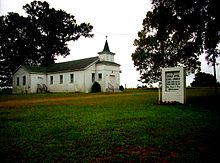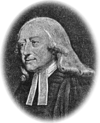- Christian Methodist Episcopal Church
-
The Christian Methodist Episcopal Church is a historically black denomination within the broader context of Methodism. The group was organized in 1870 when several black ministers, with the full support of their white counterparts in the former Methodist Episcopal Church, South, met to form an organization that would allow them to establish and maintain their own polity, that is, to ordain their own bishops and ministers without the necessity of them being officially endorsed or appointed by the white-dominated body. They called this fellowship the Colored Methodist Episcopal Church, which it remained until their successors adopted the current name in the 1950s.
 Chalk Level C.M.E. Church in Harnett County, North Carolina
Chalk Level C.M.E. Church in Harnett County, North Carolina
In the Christian Methodist Episcopal Church, bishops are administrative superintendents of the church; they are elected by "delegate" votes for as many years deemed until the age of 74, when he/she must retire. Among their duties are responsibility for appointing clergy to serve local churches as pastor, for performing ordinations, and for safeguarding the doctrine and discipline of the Church. The General Conference, a meeting every four years, comprises an equal number of clergy and lay delegates. In each Annual Conference, CME bishops serve for four-year terms. CME Church bishops may be male or female.
In 2006, there were an estimated 850,000 members in 3,500 churches.[1]
Contents
Religious beliefs
The Methodist Articles of Religion state the church's primary beliefs.
Social Creed
The C.M.E. Church has set forth a Social Creed.
Hymnal and responsive readings
Sunday worship services in the CME denomination commonly include a Responsive Reading from scripture. A leader reads a line of scripture and the congregation reads a response. Bible passages are not arranged by topic; responsive readings are. Often, a single responsive reading consists of excerpts from several Bible passages.
The CME Responsive Readings are published in The Hymnal of the Christian Methodist Episcopal Church. Items 1–545 are songs, and items 546–604 are Responsive Readings. The official Responsive Readings are from the King James Version of the Bible.
CME Connectional Emblem
 CME Connectional Emblem
CME Connectional EmblemThe official logo or symbol of the Christian Methodist Episcopal Church was originally authorized by Bishop B. Julian Smith for the Centennial General Conference held in Memphis, 1970. It was officially adopted by the General Conference in 1974 as the denomination's connectional marker.
Designed by Will E. Chambers, the logo shows the place of the Christian Methodist Episcopal Church in the rapidly changing urbanized society and its relation to God's people. The logo is composed of:
- The World Globe which represents the vineyard of God;
- The Skyline which stands for the Church's concern for human and urban problems and people's alienation from God and one another;
- The Weather Vane which symbolizes the need of the Church to be flexible in terms of meeting the contemporary needs of people; and
- The Cross which denotes, by its vertical bar, the need for a proper relationship between people and God, and by its horizontal bar, the need for proper relationships between people. The total Cross is a sign of the final-assured victory through the blood of Jesus Christ.
Ecumenical activity
The CME church has been in negotiations for many years to merge with the African Methodist Episcopal Zion Church into a tentatively named Christian Methodist Episcopal Zion Church. The plan was originally for them to unite by 2004, but this has been delayed by the AMEZ church, which, for example, insists on having "African" in the name.[2] The CMEC is very similar in doctrine and practice to that church and to the African Methodist Episcopal Church.
See also
References
- ^ "2008 Yearbook of American & Canadian Churches". The National Council of Churches. http://www.thearda.com/Denoms/D_1424.asp. Retrieved 2009-12-07.
- ^ "Two black Methodist denominations moving toward union". United Methodist News Service. Nashville, TN, USA: Worldwide Faith News. May 16, 2000. http://wfn.org/2000/05/msg00170.html. Retrieved 2009-02-18.
External links
- CME Church Website
- CME Church Publishing House
- Profile of Christian Methodist Episcopal Church on the Association of Religion Data Archives website
Methodism Background 
Distinctive doctrines Articles of Religion · Four Sources of Theological Authority · Prevenient Grace · New Birth · Governmental Atonement · Imparted righteousness · Christian perfection · Conditional preservation of the saints · Works of Piety · Works of Mercy · AssurancePeople Richard Allen · Francis Asbury · Thomas Coke · William Law · William Williams Pantycelyn · Howell Harris · Albert C. Outler · James Varick · Charles Wesley · John Wesley · George Whitefield · Countess of Huntingdon · Bishops · TheologiansLargest groups Related and
uniting movements Methodism Portal
Methodism PortalBlack church denominations and leaders Denominations 
Leaders Richard Allen · Charles Harrison Mason · Charles E. Blake · Martin Luther King, Jr · Joseph Lowery · T. D. Jakes · O. T. Jones Sr. · Jeremiah Wright · George Alexander McGuire · Gilbert E. Patterson · J.O. Patterson, Sr. · Hiram RevelsCategories Predominantly African American Christian denominations (Clergy)Categories:- African American history by location
- Christian Methodist Episcopal Church
- Predominantly African American Christian denominations
- History of Methodism in the United States
- Members of the World Council of Churches
- Religious organizations established in 1870
- Methodist denominations in North America
- Methodist denominations and unions established in the 19th century
- Members of the National Council of Churches
Wikimedia Foundation. 2010.
